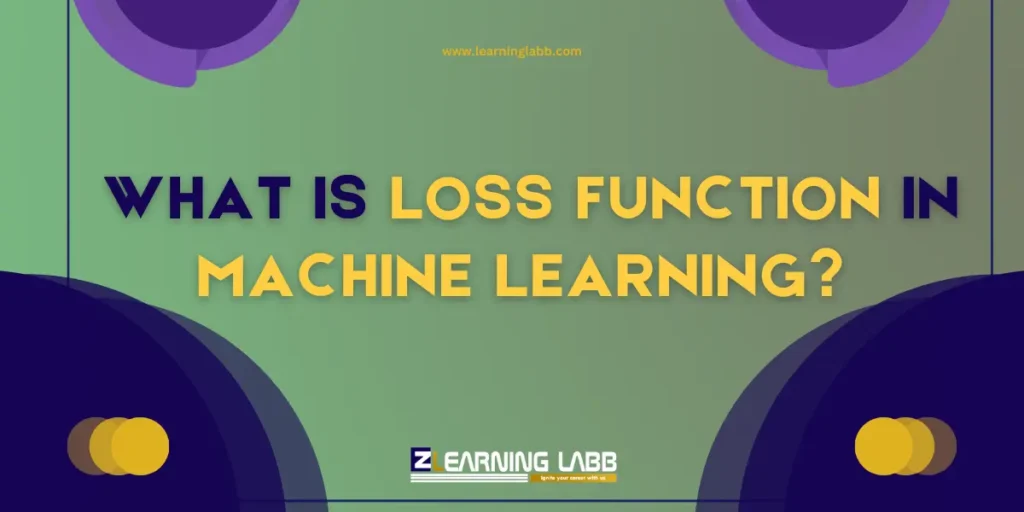What Is Loss Function In Machine Learning: Machine learning models are built to make predictions, but how do we know if a model’s predictions are correct? This is where a loss function comes into play! It measures the difference between actual and predicted values, guiding the model’s learning process.
A well-optimized loss function is the key to a highly accurate machine learning model. But what is loss function in machine learning exactly? What is the role of a loss function in machine learning? And why is it important?
What Is Loss Function in Machine Learning?
A loss function in machine learning quantifies how well (or poorly) a model’s predictions match the actual target values. It assigns a numerical value to the error, which the model then uses to improve itself.
In simpler words, it tells us: “Hey, your model is this much off from the actual values!”
Let’s say you’re predicting house prices. If a house’s actual price is ₹50 lakhs, but your model predicts ₹55 lakhs, the loss function will measure the difference of ₹5 lakhs. The smaller this difference, the better your model is performing.

What Is the Role of a Loss Function in Machine Learning?
The role of a loss function in machine learning is to provide feedback to the model so it can improve. Here’s what it does:
- Guides model training: Helps the model adjust weights and biases for better predictions.
- Measures performance: Gives a numeric value to the model’s prediction error.
- Affects optimization: The choice of a loss function impacts the efficiency of algorithms like Gradient Descent.
- Prevents overfitting or underfitting: A well-chosen loss function ensures a balance between learning and generalizing.
A well-defined loss function is the backbone of a machine learning model’s learning process.
Types of Loss Function in Machine Learning
Different tasks require different loss functions. Let’s explore the most common types:
1. Regression Loss Functions (Used for continuous data predictions)
a) Mean Squared Error (MSE)
It calculates the average of squared differences between actual and predicted values.
Formula: MSE = (1/n) * Σ(y_i – ŷ_i)^2
Best For: Models where large errors should be penalized more.
b) Mean Absolute Error (MAE)
Instead of squaring errors, it takes the absolute difference.
Formula: MAE = (1/n) * Σ|y_i – ŷ_i|
Best For: Cases where equal importance should be given to all errors.
c) Huber Loss
Combines MSE and MAE—helpful in handling outliers.
2. Classification Loss Functions (Used for categorical predictions)
a) Cross-Entropy Loss (Log Loss)
Used for multi-class classification problems. It penalizes wrong predictions heavily.
Formula: Loss = – Σ y * log(ŷ)
Best For: Classification problems like spam detection or image recognition.
b) Hinge Loss
Used in Support Vector Machines (SVMs) for better margin-based classification.

What Is the Purpose of a Loss Function in Machine Learning?
The purpose of a loss function in machine learning is simple: it helps models learn. Without a loss function, the model wouldn’t know if its predictions are good or bad!
- Helps in fine-tuning the model.
- Ensures the model improves over time.
- Helps in choosing the best hyperparameters.
Cost Function vs Loss Function – What’s the Difference?
Many beginners confuse cost function vs loss function, but they are slightly different.
- Loss function: Measures error for a single data point.
- Cost function: Measures the average error over the entire dataset.
Think of it this way: If a loss function checks one mistake at a time, a cost function looks at the bigger picture.
How to Choose the Right Loss Function for Your Model?
Choosing the correct loss function depends on:
- The type of problem (Regression or Classification)
- The dataset (Does it have outliers?)
- Model performance goals (Speed vs Accuracy)
If your data has many outliers, avoid MSE and use Huber Loss instead!
Integrating Loss Functions with Ze Learning Labb Courses
Want to master machine learning and loss functions? Check out Ze Learning courses, where experts teach:
- Real-world applications of loss functions
- How to implement them in Python
- How to optimize models effectively
Enroll today and get hands-on experience!

On A Final Note…
Understanding what is loss function in machine learning is crucial for building high-performing models. It guides training, helps in optimization, and ensures the model predicts as accurately as possible.
To summarize:
- Loss function measures prediction errors
- Different loss functions exist for regression & classification
- Cost function vs loss function – one is for single predictions, the other for the dataset
- Choosing the right loss function improves model accuracy
Want to go beyond theory and learn practical applications? Join Ze Learning Labb’s courses today and take your skills to the next level!





